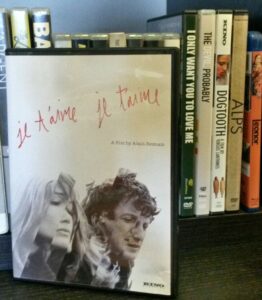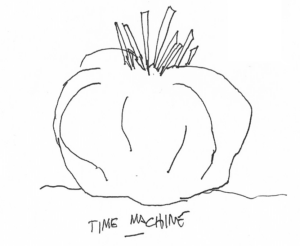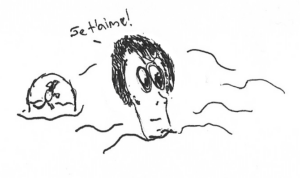Hey everybody, M. here.
As I’ve mentioned here before, I watch a lot of movies and, while I don’t consider myself a “film critic,” I like to talk about them a lot and write about them on occasion. I’ve decided to start posting movie reviews here in between author news, as that stuff tends to move slowly. You can expect some of my takes on gruesome Euro-horror, slashers from the classic era, and probably some new indie horror from time to time, as well as international art house stuff that I think could be interesting to genre fans, but may fly under the radar of strictly horror/sci-fi buffs (which is what this first post is).
A note on the name of this segment, “short ends” are the leftover, mismatched pieces of film stock that low-budget directors would often shoot movies on, leading to the variation in on-screen image quality you sometimes see. That’s sort of what I’m going for here. Anyway, enjoy this first one–which sort of spiraled into an extended critical essay on memory and time travel. They won’t always be this long. I don’t think.

Je t’aime, Je t’aime (Alain Resnais, 1968)
I had only seen two of Alain Resnais films (the big ones, Last Year at Marienbad and Hiroshima, Mon Amour) when I picked up the Olive Films release of Je t’aime, Je t’aime, but those earlier films are two of my favorites. In particular because at least in those movies, Resnais’ formal experimentation, even when it got way avant garde, had a distinct narrative purpose. As opposed to someone like the more frequently referenced Godard, whose visual experiments were (and are) showy and, in my opinion, not always particularly insightful. (An opinion that was shared, I discovered a few years ago, by frequent Godard cinematographer Raoul Coutard, who in an interview said, to paraphrase, that in every one of Godard’s film there was 20 minutes of brilliance for an hour of stuff that was completely annoying. It was a relief to hear someone spell it out.). Resnais on the other hand, at least in Marienbad and Hiroshima, used the form to illustrate a particular aspect of how people think. In Marienbad it was the circuitousness, obsessiveness and murkiness of memory in the context of trauma. In Hiroshima it was how our memories serve as direct emotional pipelines, connecting disparate events through time.
So what would Resnais do with time travel? Even given France’s tradition of arty, experimental takes on science fiction that we see in Godard’s Alphaville, Marker’s La Jetée, etc. this one is unorthodox to the extent that I keep going back and forth on if it is a time travel movie at all. It might, instead, be another take on memory, or even a movie about autobiography. This is due in part, as some special features on the disc flesh out, to an idiosyncratic director and maybe more so to an equally idiosyncratic French science-fiction author, Jacques Sternberg, acting as the film’s screenwriter.

“Why the hell is there a mouse on the beach?” “… it’s on vacation.”
The film begins with Claude Ridder checking out of a mental hospital after a suicide attempt. Ridder has slogged his way up through the publishing ranks and is, at the time of the attempt, a science fiction author (though this fact is only addressed occasionally and in passing) who has written stories or novels exploring the nature of time. The hospital is somehow affiliated with the top-secret Crespel Research Center, which has been experimenting with sending mice back in time and, now that the mice are no longer exploding, is ready to try it out on humans. Ridder’s unreformed suicidality makes him, in his own approximation and that of the research center, an ideal guinea pig for the experiment (though it’s not 100 percent clear why). Center functionaries pick him up on his way out of the hospital, pitch the idea and take him to the secret test location. He is injected with a sleep drug and placed, alongside a mouse, in a big gourd-like structure with a pillowy, doughnut-ish sort of interior. The idea is that he’ll be sent back to experience one particular minute of the past and called back to report. Things go haywire.
Ridder, unstuck in time, starts bouncing back and forth between experiences in his recent past. We’re not given any visual indication that he has been physically relocated into the past; rather the film cuts directly to a scene of Ridder snorkeling during a specific vacation with his live-in girlfriend Catrina. The scene cuts and repeats a few times, indicating “hiccups” in the time machine’s functioning. He then hops around through the previous decade of his life, and we see his recent life story told in non-linear snippets. We see him making his way through boring, banal workdays at multiple jobs. We see him waiting for a bus. We see him on a train with Catrina, discussing his wartime experiences as a soldier. We see scenes of domestic intimacy and others of presumed infidelity. Ancillary characters appear for a scene or two and drop out. Associations between historical snippets sometimes seem arbitrary. Other times, it seems like they’re driven by irrational connections of sense, sensation, emotion and so on—eventually coming to circle in around his negligent murder of Catrina, which may or may not have happened. All of this mirrors how our memories work. It’s not exactly how we’d think of a time machine working, even a broken one.
The cuts in the past speed up as the research center’s mission control in the present loses control of the situation. Ridder appears back in the time machine at irregular intervals but can’t open the door (or is afraid too, not knowing where in time he might be) and warps back out. When he is in the pod, he is in a panic–or mulling his love of Catrina, or his regret over having possibly killed her. When he is in the past, he doesn’t seem particularly aware that he has traveled through time to get there; it seems like he is remembering it, not reliving it. This makes it difficult to process the leaps Ridder takes back in time, and from time period to time period, as being distinct from flashbacks. Time travelers, fictional ones (and for all I know, real ones too) go back in time to change something, or to observe but explicitly avoid changing anything. If this is time travel and not just memory, it seems the broken machine condemns Ridder to repeat parts of his life at random in some kind of disjointed eternal recurrence.
The only real time travel “tell” that appears in Ridder’s past is his time-traveling companion, the mouse, in one beach scene. There is reason to believe, though, that Resnais had something more ambitious planned, stylistically, to visually illustrate the first-person experience of time travel.
“You won’t appear on screen.”
In Je t’aime, there’s hardly any indication that Ridder has relocated to the past. If anything it seems in the “past” scenes that his mind has warped into his past body. What we are watching is snippets of 1968 Ridder reliving 1951 onward. On first watch it feels like Resnais overlooked what makes time travel clear to a viewer. He may, however, have wanted to take on the difficult problem of depicting time travel in the first-person and just didn’t get there.
In a 2007 interview with Claude Rich (who played Claude Ridder) the Je t’aime’s star says that Resnais initially told him he, as Ridder, would not appear in the movie after the “contemporary” shots in the mental hospital and time travel pod. Rather his parts in the past would be shot in first-person perspective, or close to it, with his face appearing only in mirrors and other reflective objects coincidentally in the room. It’s hard to think through if this would have made a difference to the viewer. Though for me the concept brought to mind a time travel version of a show like Peep Show.
Resnais opted instead to place Ridder physically at the center of every scene shot in the past, which would maybe be noticeable to a director but I don’t think would stick out to even the most scrupulous audience without a heads up. While I’d like to think a perspective shift to the first person would have made it feel more time travel-ish, there’s other stuff that indicates these might have been thought of as flashbacks from the outset. Even when Rich talks about Ridder’s experiences in the film, he talks about them as memories—not things present-day Ridder is experiencing having traveled to the past. In an interview from around the same time with writer Sternberg, the tension between making a science fiction story and a personal film is likewise clear.

“I am Claude Ridder.”
Je t’aime screenwriter Sternberg’s expansive body of work, much of it science fiction, appears to have been only rarely translated into English, but fans of left-field continental progressive rock may appreciate that one of his story collections is the inspiration for the band name Univers Zéro [link is in French].
In an early-’00s interview about the film, Sternberg explains that the character of Claude Ridder is at least in part autobiographical (though it’s not clear if that means he once, like Ridder on screen, committed negligent homicide). The screenplay was, in fact, based on hundreds of small stories that Sternberg furnished Resnais with, allowing the director to choose which ones best built a coherent narrative and string them together within the science fiction framework (which was also of Sternberg’s devising).
Knowing this, the movie takes on a bit of a different shape. It’s no coincidence, for instance, that in one scene, Ridder is discussing a translation of Borges’ “Tlön, Uqbar, Orbis Tertius,” a story in which the radically skeptical metaphysics of a society that may or may not exist, described in an encyclopedia, reshape the reality of the world of the narrator. There is a Borgesian circularity to Je t’aime and Sternberg’s role in it: Sternberg was a science fiction author who was obsessed with time, writing a film about a science fiction author who is obsessed with time, who gets caught in exactly the kind of time travel loop he would write science fiction about.
Going beyond that, Sternberg utilized various concepts throughout the dialogue Je t’aime that appeared previously in his work (the quasi-science fictional notion, for instance, that humankind was created to tend to the needs of cats). And Sternberg’s own memoir, a critic explains, was built around precisely the same apparently disorganized, non-linear structure used in this film.
As movie fans, we go to the special features for clarification. These facts about Sternberg, however, seem to introduce even more ambiguity about what this movie is supposed to be.
“Why am I so interesting?”
So is Je t’aime, Je t’aime science fiction? Is it something closer to surrealism (at points, it certainly resembles the work of Buñuel in the late-’60s/early-’70s)? Is it a personal art house film shot cut-up style for the hell of it? Is it an experimental anthology with an Amicus-style science fiction wraparound story? Is it a work of cinematic proto-hypertext? Could what it does be accomplished with no science fiction element at all–having Ridder wake up in an asylum, obsessed with the same things, unable to escape the weight of his memories until he is eventually overwhelmed by them?
The action of the film itself raises questions as well: why towards the end of the film do we start seeing surreal dream vignettes interspersed between Ridder’s past experiences? Why does Ridder at one point sink up to his neck in the doughnut? Is that a hallucination? A result of the failing time machine? Another dream?
Around 2005 I got sort of obsessed with the then recently-released Shaun of the Dead. A big part of this was because the movie was driven by a heartbeat of realism—comic realism, but realism—it (and the two follow-up movies) seemed to fundamentally be about what would happen if people who would go to see a movie like Shaun of the Dead ended up experiencing a zombie attack. It wasn’t just a horror-comedy, it was a personal horror-comedy that spoke specifically to the idiosyncrasies of the lives of its audience. While I couldn’t tell you ever Edgar Wright and Co ever saw Je t’aime, maybe there’s something to be said for Je t’aime’s blending of hyper-personal and genre as a sort of artsier, distant ancestor of those types of movies. Or even a precursor to something like Fulci’s Cat in the Brain, (even with Fulci’s movie being more directly a gore-filled riff on Fellini’s 8 ½).
Je t’aime is definitely not Resnais’ most consistent use of visual style to explore facets of the human experience. And I do think the experimentalism at times competes with the storytelling. In Ridder’s suicide scene, for instance, the desperate, weary contemplation and sudden commitment has an air of verisimilitude that makes it resonate nearly as strongly as the suicide of Alain Leroy (Maurice Ronet) in Louie Malle’s heartwrenching The Fire Within (one of my favorite movies). It struck me that scenes like this could have been stronger were they tied together with a more conventional narrative. Sternberg had no problem reusing scenes for other literary purposes, but Resnais didn’t, to my knowledge, do the same thing on screen.
Je t’aime has, if anything, gotten me interested in reading the works of Jacques Sternberg and revisiting the discography of Univers Zéro. I am still stumped on if this is really a time travel movie or not, or frankly if that is even an important question. Anyway, a person purporting to be me from the future just materialized in my apartment, warning me not to post this review. I now have to go kill him.
-M.
